英语修辞赏析
大学英语修辞赏析及其教学意义
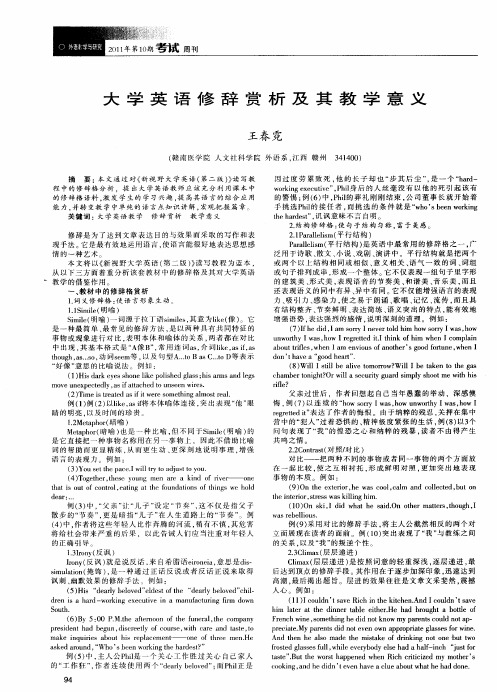
、
11 i l( 喻 ) .Smi 明 e
Sm l( 喻 ) 词 源 于拉 丁语 s i s 其 意 为l e 像 ) ii 明 e 一 i l , m e i ( 。它 k 是 一 种最 简 单 、 常 见 的修 辞 方 法 , 以 两种 具 有 共 同特 征 的 最 是 事 物 或现 象 进 行 对 比 , 明本 体 和 喻 体 的 关 系 , 者 都 在 对 比 表 两 中 出 现 , 基 本 格 式 是 “ 像 B , 用 连 词 a , 词l e a i a 其 A ”常 s介 i ,s f s k , to g .s s . 词 se h uh a… o 动 e m等 . 及 句 型 A t B a C t D等 表 示 以 … o s … o “ 好像 ” 思 的 比喻 说 法 。例 如 : 意
( ) s ake e h n k oi e ls ; i amsa dlg 1 Hi r y ss o el ep l h dgas hs r n s d i s e
mo eu e p c e l a tc e n e n w rs v n x e t dy, si a a h dt u s e i . ft o e
大 学 英 语 修 辞 赏 析 及 其 教 学 意 义
王 春 霓
( 南 医学 院 人 文社 科 学 院 外 语 系 , 赣 江西 赣 州 3 1 0 ) 4 4 0 摘 要 : 文通过对《 本 新视 野 大 学 英 语 ( 二 版 ) 读 写教 第 》 程 中 的修 辞 格 分析 ,提 出 大 学 英语 教 师应 该 充 分 利 用课 本 中 的修 辞 格 语 料 . 发 学生 的 学 习兴 趣 , 高其 语 言 的综 合 应 用 激 提 能力, 并转 变教 学 中单 纯 的语 言点 知 识 讲 解 , 观把 握 篇 章 。 宏 关 键 词 :大学 英 语 教 学 修 辞 赏析 教 学 意 义 修 辞是 为 了达 到 文 章 表 达 目的 与 效 果 而 采 取 的 写作 和表 现 手 法 。 是最 有 效 地 运 用 语 言 , 语 言 能很 好 地 表 达 思 想感 它 使 情 的 一种 艺 术 。 本文将以《 视 野大学英语 ( 二版 )读写教程 为蓝本 , 新 第 》 从 以 下 三方 面 着 重 分 析 该 套 教 材 中 的 修 辞 格及 其对 大学 英 语 教 学 的借 鉴 作 用 。 教 材 中 的修 辞 格 赏 析 1词 义修 辞 格 : 语 言 形 象 生动 。 . 使
英语修辞antithesis的用法及例句赏析

今天,小兔将给大家介绍一种英文修辞手法“Antithesis(对偶)”Antithesis is a figure of speech which is a contrast of ideas expressed by parallelism of strongly contrasted words, generally for a tuneful rhythm and wisdom of brevity.对偶也可称为“平行对照”,是由结构平行的词语,从句,或句子排列而成,语义上相互对立或对照的一种修辞格,即contrast+parallelism。
对偶与矛盾修辞(Oxymoron)不同,对偶旨在显示前后两部分的平行对立,且常讲究对应词语对仗;矛盾修辞则旨在突出主从两部分的矛盾统一。
英汉对偶基本类似,因为两者都是将意义相对或相反的字、词、短语、句子(或句子成分)一一对应地排列起来,强调其差异,突出其矛盾,赋予文字以极大的感染力,从而表达一个深层的题旨。
从音、形、义三方面看,它音律节奏铿锵,形式整齐匀称,内容既适于重复强调,又适于反衬对照,在诗词、议论文、演说、寓言、谚语、成语、对联或广告中特别常见。
英语中对偶可分为四种,即单词(single words),短语(phrases),从句(clauses)和句子(sentences)。
(1)single wordsArt is long, life is short. 人生有限,学问无穷。
Easy come, easy go. 来得容易去得快。
Out of sight, out of mind. 眼不见,心不烦。
Man proposes ,God disposes. 谋事在人,成事在天。
Like father, like son. 有其父必有其子。
I take thee to my wedded wife, to have and to hold from this day forward, for better or worse, for richer or poorer, in sickness and in health, to love and cherish, till death do we part, according to God’s holy ordinance, and thereto I plight thee my troth.我愿遵照上帝圣仪,娶汝为妻。
英语文学作品中比喻修辞格赏析
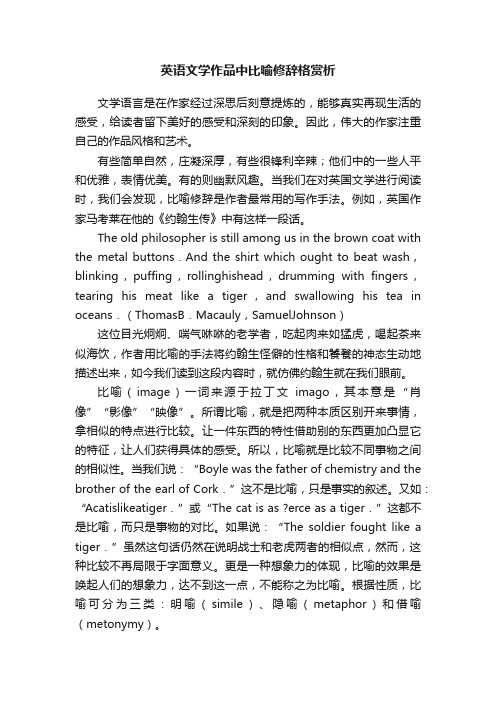
英语文学作品中比喻修辞格赏析文学语言是在作家经过深思后刻意提炼的,能够真实再现生活的感受,给读者留下美好的感受和深刻的印象。
因此,伟大的作家注重自己的作品风格和艺术。
有些简单自然,庄凝深厚,有些很锋利辛辣;他们中的一些人平和优雅,表情优美。
有的则幽默风趣。
当我们在对英国文学进行阅读时,我们会发现,比喻修辞是作者最常用的写作手法。
例如,英国作家马考莱在他的《约翰生传》中有这样一段话。
The old philosopher is still among us in the brown coat with the metal buttons.And the shirt which ought to beat wash,blinking,puffing,rollinghishead,drumming with fingers,tearing his meat like a tiger,and swallowing his tea in oceans.(ThomasB.Macauly,SamuelJohnson)这位目光炯炯、喘气咻咻的老学者,吃起肉来如猛虎,喝起茶来似海饮,作者用比喻的手法将约翰生怪僻的性格和饕餮的神态生动地描述出来,如今我们读到这段内容时,就仿佛约翰生就在我们眼前。
比喻(image)一词来源于拉丁文imago,其本意是“肖像”“影像”“映像”。
所谓比喻,就是把两种本质区别开来事情,拿相似的特点进行比较。
让一件东西的特性借助别的东西更加凸显它的特征,让人们获得具体的感受。
所以,比喻就是比较不同事物之间的相似性。
当我们说:“Boyle was the father of chemistry and the brother of the earl of Cork.”这不是比喻,只是事实的叙述。
又如:“Acatislikeatiger.”或“The cat is as ?erce as a tiger.”这都不是比喻,而只是事物的对比。
英语文学作品中修辞手法的赏析

不 冒进, 以平和的心态来面对一切 其次, 矛盾 的修 之 间有 相同的特征 , 英语文学中的明喻随处可见 , 一般 以 a s i f 握好度 , / a s t h o u g h t / l i k e 等词作为标志, 例如 , L i f e b e b e a u t i f u 1 l i k e s u m- 辞手法能使文学作品的表现力与感染力得到增强,通过事物 让读者在感官上得到刺激 , 在 审美上得 me r l f o w e r s a n d d e a t h l i k e a u t u mn l e a v e s ( 生如夏花之绚烂 , 死 内存矛盾 的鲜明对比, 如I i f n d n o p e a c e , a n da l l myw a r i s d o n e( 我 没 有 找 到 如秋叶之静 美) , 泰戈尔 的这句诗巧用 比喻的修辞技法 , 把 生 到愉 悦 ,
英语 文学作 品中修辞 手法 的赏析
潘 启玲
( 商 丘职 技 术 学院
摘 要 些常用修辞 , 学会鉴 赏英语文 学作 品之美。 关键词 英语文学 修辞手法 文献标识码 : A 中图分类号: H3 1 9
河南 ・ 商丘
4 7 6 0 0 0 )
英语文学作品中的修辞赏析
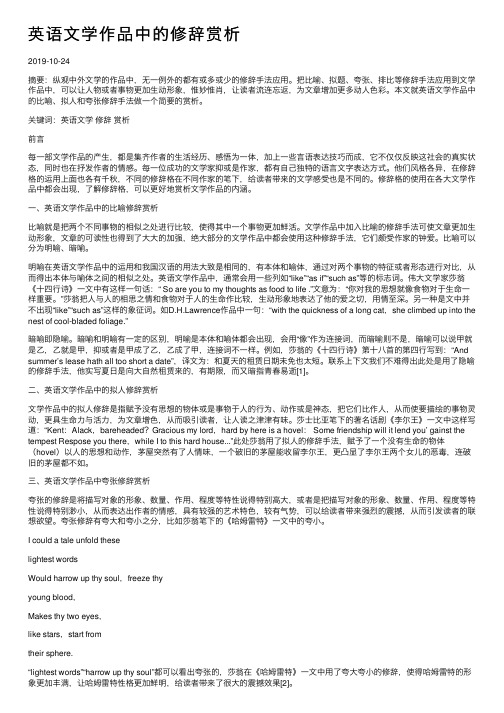
英语⽂学作品中的修辞赏析2019-10-24摘要:纵观中外⽂学的作品中,⽆⼀例外的都有或多或少的修辞⼿法应⽤。
把⽐喻、拟题、夸张、排⽐等修辞⼿法应⽤到⽂学作品中,可以让⼈物或者事物更加⽣动形象,惟妙惟肖,让读者流连忘返,为⽂章增加更多动⼈⾊彩。
本⽂就英语⽂学作品中的⽐喻、拟⼈和夸张修辞⼿法做⼀个简要的赏析。
关键词:英语⽂学修辞赏析前⾔每⼀部⽂学作品的产⽣,都是集齐作者的⽣活经历、感悟为⼀体,加上⼀些⾔语表达技巧⽽成,它不仅仅反映这社会的真实状态,同时也在抒发作者的情感。
每⼀位成功的⽂学家抑或是作家,都有⾃⼰独特的语⾔⽂字表达⽅式。
他们风格各异,在修辞格的运⽤上⾯也各有千秋,不同的修辞格在不同作家的笔下,给读者带来的⽂学感受也是不同的。
修辞格的使⽤在各⼤⽂学作品中都会出现,了解修辞格,可以更好地赏析⽂学作品的内涵。
⼀、英语⽂学作品中的⽐喻修辞赏析⽐喻就是把两个不同事物的相似之处进⾏⽐较,使得其中⼀个事物更加鲜活。
⽂学作品中加⼊⽐喻的修辞⼿法可使⽂章更加⽣动形象,⽂章的可读性也得到了⼤⼤的加强,绝⼤部分的⽂学作品中都会使⽤这种修辞⼿法,它们颇受作家的钟爱。
⽐喻可以分为明喻、暗喻。
明喻在英语⽂学作品中的运⽤和我国汉语的⽤法⼤致是相同的,有本体和喻体,通过对两个事物的特征或者形态进⾏对⽐,从⽽得出本体与喻体之间的相似之处。
英语⽂学作品中,通常会⽤⼀些列如“like”“as if”“such as”等的标志词。
伟⼤⽂学家莎翁《⼗四⾏诗》⼀⽂中有这样⼀句话:“ So are you to my thoughts as food to life .”⽂意为:“你对我的思想就像⾷物对于⽣命⼀样重要。
”莎翁把⼈与⼈的相思之情和⾷物对于⼈的⽣命作⽐较,⽣动形象地表达了他的爱之切,⽤情⾄深。
另⼀种是⽂中并不出现“like”“such as”这样的象征词。
如wrence作品中⼀句:“with the quickness of a long cat,she climbed up into the nest of cool-bladed foliage.”暗喻即隐喻。
英语文学作品中比喻修辞格赏析

1.引言在英语文学作品中,比喻是一种常见的修辞手法,通过对比或象征的方式来表达作者的意思。
比喻修辞格不仅在文学作品中常见,也在日常生活中广泛应用。
比喻的赏析需要我们深入理解作者的用意,以及比喻所涉及的象征意义。
在本文中,我将对英语文学作品中比喻修辞格进行深度赏析。
2.比喻的定义与特点比喻是一种通过对比或象征来表达含义的修辞手法。
它常常将一种事物或概念与另一种事物或概念进行类比,以便更生动、更具体地表达某种含义。
比喻的特点在于它不是字面上的意思,而是通过暗示或比拟来传达某种深层含义。
3.比喻在文学作品中的应用在英语文学作品中,比喻被广泛运用,不论是诗歌、散文还是小说,都可以看到比喻的身影。
莎士比亚的经典作品《哈姆雷特》中就运用了大量的比喻来表达角色的内心世界和情感。
比喻的应用使作品更加生动、深刻,能够让读者更好地理解作者的用意。
4.比喻的深度赏析在赏析一篇文学作品中的比喻时,我们首先需要明确作者的用意,比如作者为何选择了这个比喻,它所暗示的含义是什么等等。
需要理解比喻所涉及的象征意义,这需要我们对文学作品的背景和历史有一定的了解。
只有深入赏析比喻,才能真正理解文学作品的内涵和艺术价值。
5.个人观点和理解我认为比喻是一种极具魅力的修辞手法,在文学作品中的应用可以让作品更具艺术感和表现力。
通过对比或象征的方式来传达作者的情感和思想,不仅可以增加作品的趣味性,也可以让读者更深入地理解作品。
在阅读文学作品时,我会特别关注作者的比喻运用,以便更全面地理解作品的内涵。
6.总结通过本文的深度赏析,我们对英语文学作品中的比喻修辞格有了更深入的了解。
比喻不仅是一种修辞手法,更是作品中表达作者意图的重要方式。
在阅读文学作品时,我们可以通过对比喻的赏析来更好地理解作者的用意,更深刻地体会作品的艺术魅力。
结语:通过本篇文章,我希望你可以更好地理解英语文学作品中的比喻修辞格,以及它在作品中的重要作用。
希望你在阅读和赏析文学作品时,能够更深入地关注作者的比喻运用,从而更好地理解作品的内涵和艺术价值。
英语修辞手法分析

英语修辞手法分析英语修辞手法分析一般的者认为,语法是研究词的变化和遣词造句的规则,而修辞则是依据题旨情境,恰当地选择语言手段,选择表达方式,以有效地表达思想感情。
一般认为只有运用辞格(比喻、借代、提喻、拟人、讽喻、代换、双关、婉言、夸张等)才是修辞。
其实不然,在很多情况下,运用英语的语法,也能达到修辞效果,这就是通常所说的语法修辞也称为消极修辞,它是没有相对固定格式的修饰性写作技巧,是运用语法对语言进行描写,使演讲和写作更能有达意,传神之功效。
以下为常见的几种具有修辞作用的语法现象。
I 动词时态的修辞作用就英语和汉语而论,动词时态只属英语范畴。
在汉语中,动词的词形不因行为的时间而变化,行为、举止和事件的发生的时间不体现在谓语动词的变化上。
而英语中的动词,其形式因时间而异,同一动词的不同形式不仅可表示出动词动作的时间和体态,在一些创造性作家手中,也可以用来作为一种修饰语言的技巧,使正规语言变得更为生动、形象、逼真。
例如:1、I’m telling you, I nearly fainted on the spot last week. I’m in the sitting-room with my wife, when this chap next door staggers past and in a drunken fit throws a brick through our window.作者为了强化过去行为,使之具有现实性,文中使用了动词的一般现在时,这里用一般现在时来叙述往事,增强了描写的生动性和真实感,使情节形象逼真,以前一系列的动作宛如发生在读者眼前一般,栩栩如生。
这一语法修辞手法称为历史性现在时或戏剧性现在时。
2、A wood fire was burning on the hearth,and a cat was sleeping in front of it.A girl was playing the piano and singing softly to herself. Suddenly there was a knock on the door.The girl stopped playing.The cat woke up.四个进行时的连续使用,把一幅生动真实的冬日之夜的画面展现出来,一派安闲自得的气氛弥漫在空气之中,这为后来动作发生的突变作了铺垫。
高级英语中的修辞手法总结带课文中例句
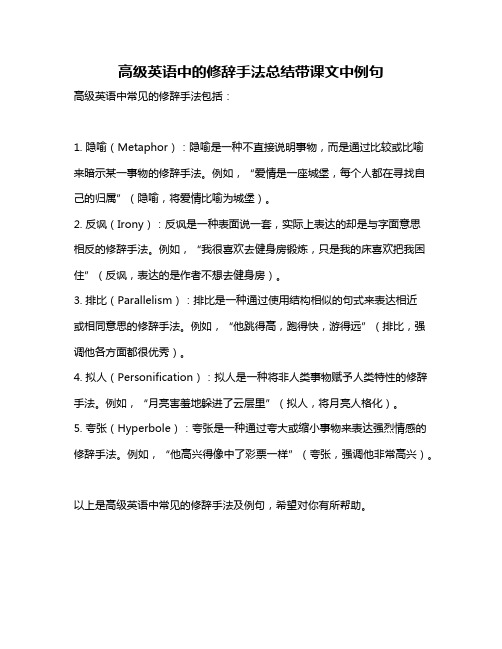
高级英语中的修辞手法总结带课文中例句
高级英语中常见的修辞手法包括:
1. 隐喻(Metaphor):隐喻是一种不直接说明事物,而是通过比较或比喻来暗示某一事物的修辞手法。
例如,“爱情是一座城堡,每个人都在寻找自己的归属”(隐喻,将爱情比喻为城堡)。
2. 反讽(Irony):反讽是一种表面说一套,实际上表达的却是与字面意思
相反的修辞手法。
例如,“我很喜欢去健身房锻炼,只是我的床喜欢把我困住”(反讽,表达的是作者不想去健身房)。
3. 排比(Parallelism):排比是一种通过使用结构相似的句式来表达相近
或相同意思的修辞手法。
例如,“他跳得高,跑得快,游得远”(排比,强调他各方面都很优秀)。
4. 拟人(Personification):拟人是一种将非人类事物赋予人类特性的修辞手法。
例如,“月亮害羞地躲进了云层里”(拟人,将月亮人格化)。
5. 夸张(Hyperbole):夸张是一种通过夸大或缩小事物来表达强烈情感的修辞手法。
例如,“他高兴得像中了彩票一样”(夸张,强调他非常高兴)。
以上是高级英语中常见的修辞手法及例句,希望对你有所帮助。
英语修辞赏析
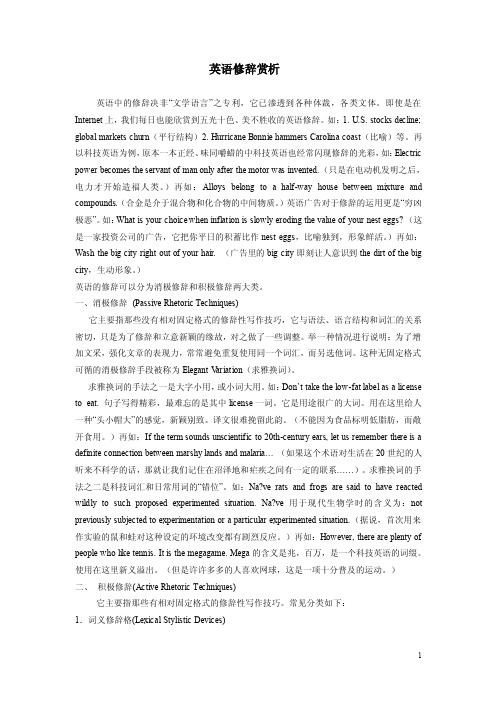
英语修辞赏析英语中的修辞决非“文学语言”之专利,它已渗透到各种体裁,各类文体。
即使是在Internet上,我们每日也能欣赏到五光十色、美不胜收的英语修辞。
如:1. U.S. stocks decline; global markets churn(平行结构)2. Hurricane Bonnie hammers Carolina coast(比喻)等。
再以科技英语为例,原本一本正经、味同嚼蜡的中科技英语也经常闪现修辞的光彩,如:Electric power becomes the servant of man only after the motor was invented.(只是在电动机发明之后,电力才开始造福人类。
)再如:Alloys belong to a half-way house between mixture and compounds.(合金是介于混合物和化合物的中间物质。
)英语广告对于修辞的运用更是“穷凶极恶”。
如:What is your choice when inflation is slowly eroding the value of your nest eggs? (这是一家投资公司的广告,它把你平日的积蓄比作nest eggs,比喻独到,形象鲜活。
)再如:Wash the big city right out of your hair. (广告里的big city即刻让人意识到the dirt of the big city,生动形象。
)英语的修辞可以分为消极修辞和积极修辞两大类。
一、消极修辞(Passive Rhetoric Techniques)它主要指那些没有相对固定格式的修辞性写作技巧,它与语法、语言结构和词汇的关系密切,只是为了修辞和立意新颖的缘故,对之做了一些调整。
举一种情况进行说明:为了增加文采,强化文章的表现力,常常避免重复使用同一个词汇,而另选他词。
英语修辞手法分析大全+英语文章分析赏析
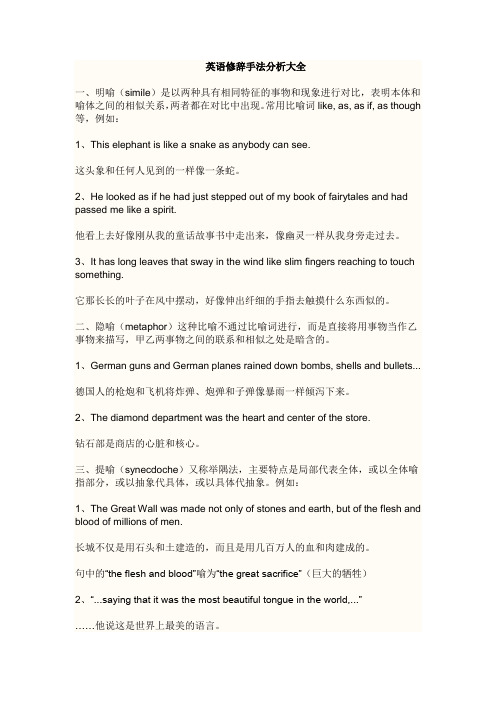
英语修辞手法分析大全一、明喻(simile)是以两种具有相同特征的事物和现象进行对比,表明本体和喻体之间的相似关系,两者都在对比中出现。
常用比喻词like, as, as if, as though 等,例如:1、This elephant is like a snake as anybody can see.这头象和任何人见到的一样像一条蛇。
2、He looked as if he had just stepped out of my book of fairytales and had passed me like a spirit.他看上去好像刚从我的童话故事书中走出来,像幽灵一样从我身旁走过去。
3、It has long leaves that sway in the wind like slim fingers reaching to touch something.它那长长的叶子在风中摆动,好像伸出纤细的手指去触摸什么东西似的。
二、隐喻(metaphor)这种比喻不通过比喻词进行,而是直接将用事物当作乙事物来描写,甲乙两事物之间的联系和相似之处是暗含的。
1、German guns and German planes rained down bombs, shells and bullets...德国人的枪炮和飞机将炸弹、炮弹和子弹像暴雨一样倾泻下来。
2、The diamond department was the heart and center of the store.钻石部是商店的心脏和核心。
三、提喻(synecdoche)又称举隅法,主要特点是局部代表全体,或以全体喻指部分,或以抽象代具体,或以具体代抽象。
例如:1、The Great Wall was made not only of stones and earth, but of the flesh and blood of millions of men.长城不仅是用石头和土建造的,而且是用几百万人的血和肉建成的。
英语语法:英语的19种修辞手法分析
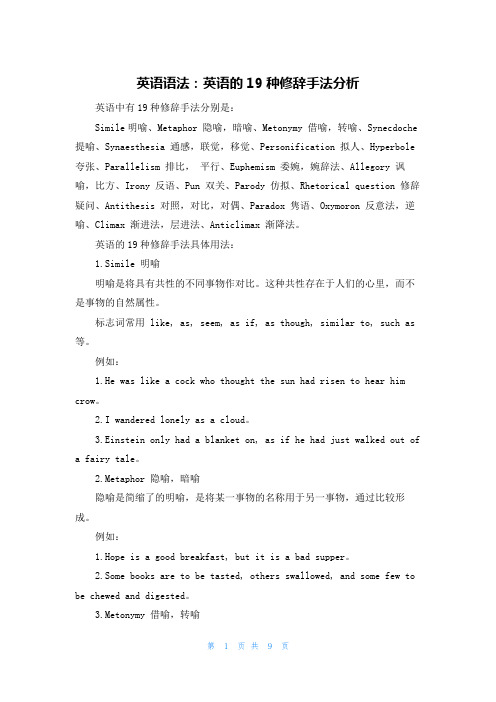
英语语法:英语的19种修辞手法分析英语中有19种修辞手法分别是:Simile明喻、Metaphor 隐喻,暗喻、Metonymy 借喻,转喻、Synecdoche 提喻、Synaesthesia 通感,联觉,移觉、Personification 拟人、Hyperbole 夸张、Parallelism 排比,平行、Euphemism 委婉,婉辞法、Allegory 讽喻,比方、Irony 反语、Pun 双关、Parody 仿拟、Rhetorical question 修辞疑问、Antithesis 对照,对比,对偶、Paradox 隽语、Oxymoron 反意法,逆喻、Climax 渐进法,层进法、Anticlimax 渐降法。
英语的19种修辞手法具体用法:1.Simile 明喻明喻是将具有共性的不同事物作对比。
这种共性存在于人们的心里,而不是事物的自然属性。
标志词常用 like, as, seem, as if, as though, similar to, such as 等。
例如:1.He was like a cock who thought the sun had risen to hear him crow。
2.I wandered lonely as a cloud。
3.Einstein only had a blanket on, as if he had just walked out ofa fairy tale。
2.Metaphor 隐喻,暗喻隐喻是简缩了的明喻,是将某一事物的名称用于另一事物,通过比较形成。
例如:1.Hope is a good breakfast, but it is a bad supper。
2.Some books are to be tasted, others swallowed, and some few to be chewed and digested。
大学英语教学中英语修辞格的赏析
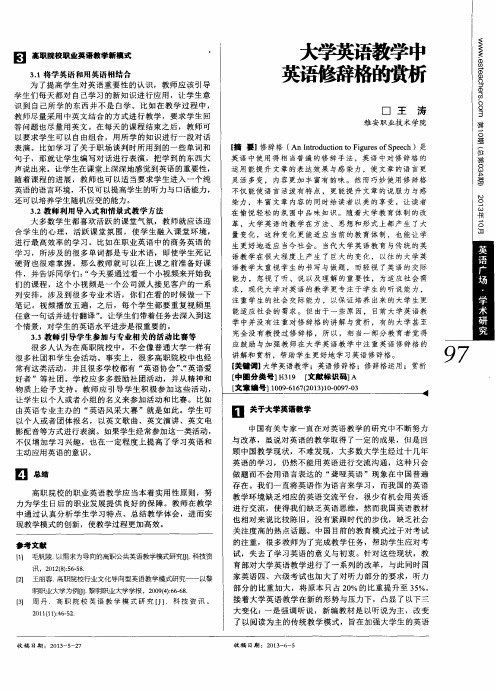
i l关 于 大 学 英 语 教 学
中国有关: 争 家 一 直 在 对 英 语 教 学 的 研 究 中不 断努 与 改 革 ,虽 说 对 英 语 的 教 学 取 得 了一 定 的 成 果 ,但 是 匣
英语修辞格的赏析
口 王 涛
雅 安 职 业技 术 学 院 【 摘 要】 修辞格 ( An I n t r o d u c t i o n t o F i g u r e s o f S p e e c h)是
英语 中使 用得相 当普遍 的修 辞手法 ,英语 中对修辞格 的 运 用 能 提 升 文 章的 表 达 效 果 与 感 染 力 ,使 文 章 的语 言 更 灵 活 多 变 , 内容 更 加 丰 富有 韵 味 。 然 而 巧 妙 使 用 修 辞 格
语 教 学 太 重视 ! 学生 的 书 写 与 做 题 , 而 轻 视 了英 语 的 交 际
能 力 , 忽视 了 听 、说 以 及 理 解 的 重 要 性 ,为 适 应 社 会 需 求 ,现 代 大 学 对 英 语 的 教 学 更 专 注 于 学 生 的 听说 能 力 ,
注重 学生的社会 交际能力 ,以保 证培养 出来 的大学 生更 能 适 应 社 会 的 需求 。 但 由于 一 些 原 因 , 目前 大 学 英 语 教 学 中并 没 有 注 重 对 修 辞 格 的讲 解 与 赏 析 ,有 的 大 学 甚 至
【 中圈分类号] K3 1 9 [ 文 献 标 识 码] A
9 7
【 文章编号] 1 0 0 9 — 6 1 6 7 ( 2 0 1 3 ) 1 0 — 0 0 9 7 . 0 3
英语修辞和赏析
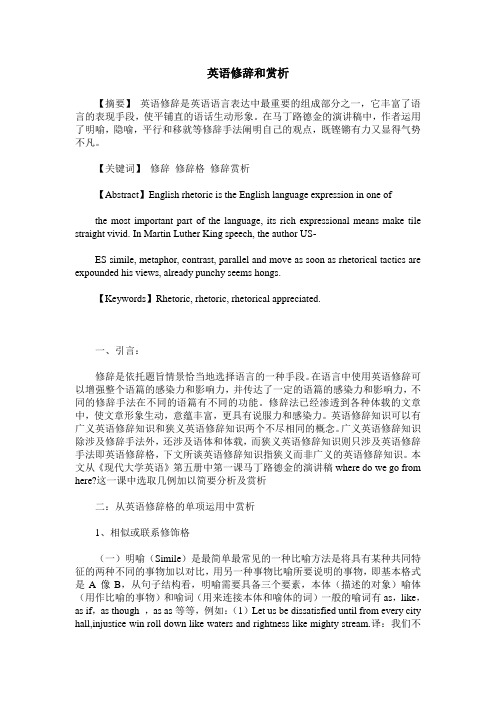
英语修辞和赏析【摘要】英语修辞是英语语言表达中最重要的组成部分之一,它丰富了语言的表现手段,使平铺直的语话生动形象。
在马丁路德金的演讲稿中,作者运用了明喻,隐喻,平行和移就等修辞手法阐明自己的观点,既铿锵有力又显得气势不凡。
【关键词】修辞修辞格修辞赏析【Abstract】English rhetoric is the English language expression in one ofthe most important part of the language, its rich expressional means make tile straight vivid. In Martin Luther King speech, the author US-ES simile, metaphor, contrast, parallel and move as soon as rhetorical tactics are expounded his views, already punchy seems hongs.【Keywords】Rhetoric, rhetoric, rhetorical appreciated.一、引言:修辞是依托题旨情景恰当地选择语言的一种手段。
在语言中使用英语修辞可以增强整个语篇的感染力和影响力,并传达了一定的语篇的感染力和影响力,不同的修辞手法在不同的语篇有不同的功能。
修辞法已经渗透到各种体载的文章中,使文章形象生动,意蕴丰富,更具有说服力和感染力。
英语修辞知识可以有广义英语修辞知识和狭义英语修辞知识两个不尽相同的概念。
广义英语修辞知识除涉及修辞手法外,还涉及语体和体载,而狭义英语修辞知识则只涉及英语修辞手法即英语修辞格,下文所谈英语修辞知识指狭义而非广义的英语修辞知识。
本文从《现代大学英语》第五册中第一课马丁路德金的演讲稿where do we go from here?这一课中选取几例加以简要分析及赏析二:从英语修辞格的单项运用中赏析1、相似或联系修饰格(一)明喻(Simile)是最简单最常见的一种比喻方法是将具有某种共同特征的两种不同的事物加以对比,用另一种事物比喻所要说明的事物,即基本格式是A 像B,从句子结构看,明喻需要具备三个要素,本体(描述的对象)喻体(用作比喻的事物)和喻词(用来连接本体和喻体的词)一般的喻词有as,like,as if,as though ,as as等等,例如:(1)Let us be dissatisfied until from every city hall,injustice win roll down like waters and rightness like mighty stream.译:我们不会感到满意除非某个市政府里公平如浪涛滚滚,正义如江河滔滔。
英语修辞鉴赏 论文
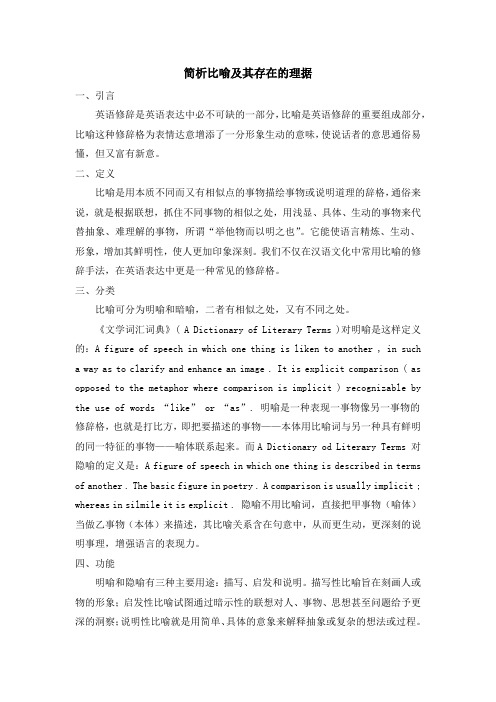
简析比喻及其存在的理据一、引言英语修辞是英语表达中必不可缺的一部分,比喻是英语修辞的重要组成部分,比喻这种修辞格为表情达意增添了一分形象生动的意味,使说话者的意思通俗易懂,但又富有新意。
二、定义比喻是用本质不同而又有相似点的事物描绘事物或说明道理的辞格,通俗来说,就是根据联想,抓住不同事物的相似之处,用浅显、具体、生动的事物来代替抽象、难理解的事物,所谓“举他物而以明之也”。
它能使语言精炼、生动、形象,增加其鲜明性,使人更加印象深刻。
我们不仅在汉语文化中常用比喻的修辞手法,在英语表达中更是一种常见的修辞格。
三、分类比喻可分为明喻和暗喻,二者有相似之处,又有不同之处。
《文学词汇词典》( A Dictionary of Literary Terms )对明喻是这样定义的:A figure of speech in which one thing is liken to another , in such a way as to clarify and enhance an image . It is explicit comparison ( as opposed to the metaphor where comparison is implicit ) recognizable by the use of words “like” or “as”.明喻是一种表现一事物像另一事物的修辞格,也就是打比方,即把要描述的事物——本体用比喻词与另一种具有鲜明的同一特征的事物——喻体联系起来。
而A Dictionary od Literary Terms 对隐喻的定义是:A figure of speech in which one thing is described in terms of another . The basic figure in poetry . A comparison is usually implicit ; whereas in silmile it is explicit . 隐喻不用比喻词,直接把甲事物(喻体)当做乙事物(本体)来描述,其比喻关系含在句意中,从而更生动,更深刻的说明事理,增强语言的表现力。
英文常用的修辞手法
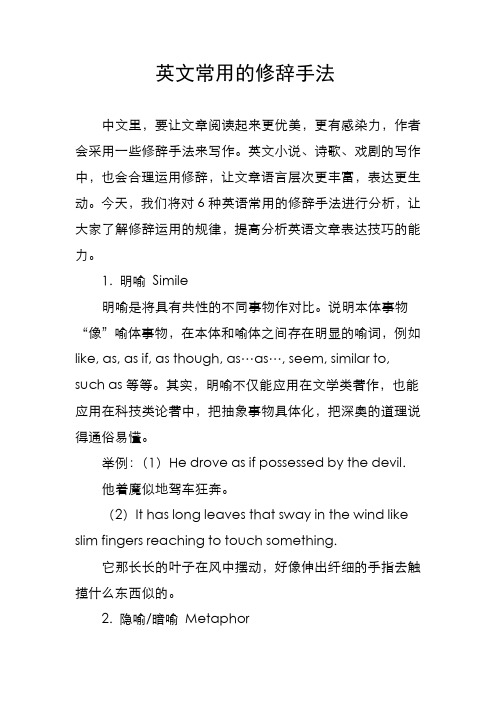
英文常用的修辞手法中文里,要让文章阅读起来更优美,更有感染力,作者会采用一些修辞手法来写作。
英文小说、诗歌、戏剧的写作中,也会合理运用修辞,让文章语言层次更丰富,表达更生动。
今天,我们将对6种英语常用的修辞手法进行分析,让大家了解修辞运用的规律,提高分析英语文章表达技巧的能力。
1. 明喻Simile明喻是将具有共性的不同事物作对比。
说明本体事物“像”喻体事物,在本体和喻体之间存在明显的喻词,例如like, as, as if, as though, as…as…, seem, similar to, such as等等。
其实,明喻不仅能应用在文学类著作,也能应用在科技类论著中,把抽象事物具体化,把深奥的道理说得通俗易懂。
举例:(1)He drove as if possessed by the devil.他着魔似地驾车狂奔。
(2)It has long leaves that sway in the wind like slim fingers reaching to touch something.它那长长的叶子在风中摆动,好像伸出纤细的手指去触摸什么东西似的。
2. 隐喻/暗喻Metaphor隐喻/暗喻,是根据两个事物的某些共同特征,用一事物去暗示另一事物,本体和喻体间没有明显的比喻词,但常常用be来做连接,也可以将be理解为喻词,有时也会用become, turn into等词,是指在暗中打比方。
举例:(1)He has a heart of stone.他铁石心肠。
(2)Hope is a good breakfast, but it is a bad supper.3. 拟人Personification所谓拟人,就是把生命赋予无生命的事物,例如将人的特点加于事物之上。
拟人法运用得好,不仅使语言表达得生动、有力,而且给人以亲切、实在的感受。
举例:(1)How soon hath Time, the subtle thief of youth, stolen on his wing my three and twentieth year!时间,这个盗窃青春的狡猾的小偷,盗窃了我二十又三年!(把时间比拟成小偷)4. 夸张Hyperbole夸张,就是把事物的特征有意地加以夸大或缩小,即“言过其实”,可以加强语势,达到强调的效果。
《高级英语》教材中的修辞格赏析

- 110-校园英语 / 基础教育研究《高级英语》教材中的修辞格赏析河北省承德市翠桥中学/孔敏【摘要】英语修辞越来越多的为人们所应用于报纸,广播,杂志,文学作品以及日常生活中。
本文拟从《高级英语》教材中的一些修辞手法入手,从英语意象方面进行分析、赏欣,使读者认识到英语修辞在语言表达中的重要作用。
【关键词】修辞 修辞格 赏析修辞(rhetoric)就是在应用语言的时候,根据特定的目的,精心的选择语言的过程。
运用各种语言文字材料,各种表现手法,来恰当地表达思想和感情,力求把话说得更正确、明白,使文章更加的生动、精彩。
修辞格(figures of speech)是在修饰语言的过程中,形成的具有独特的表达效果的比较固定的格式,也称修辞手段,修辞方式等。
恰当的使用修辞格,可以使语言生动形象,意蕴优美,更具说服力和感染力。
现从英语意象方面就《高级英语》教材中的修辞格进行发掘和赏欣。
1.明喻 (simile)。
(1) I see also the dull, drilled, docile, brutish masses of the Hun soldiery plodding on like a swarm of crawling locusts. (Speech on Hitler’s Invasion of the U.S.S.R.)(2) The wind (Hurricane Camile) sounded like the roar ofa train passing a few yards away. (Face to Face with Hurricane Camile)句(1)摘自于英国首相丘吉尔《关于希特勒入侵苏联的讲话》。
这位强悍的英国首相把德国凶残,野蛮的士兵比作成群结队,且对农作物可以造成灭顶之灾的蝗虫。
因为两者有着共同的特点——制造毁灭,深刻的揭露并批判了德国法西斯的凶残。
句(2)中作者把卡米尔号飓风的声响(the sound of the wind)比作在身边呼啸而过的列车发出的响声(the roar of a passing train),非常的贴切、生动、形象。
英语常见修辞手法的语用功能分析
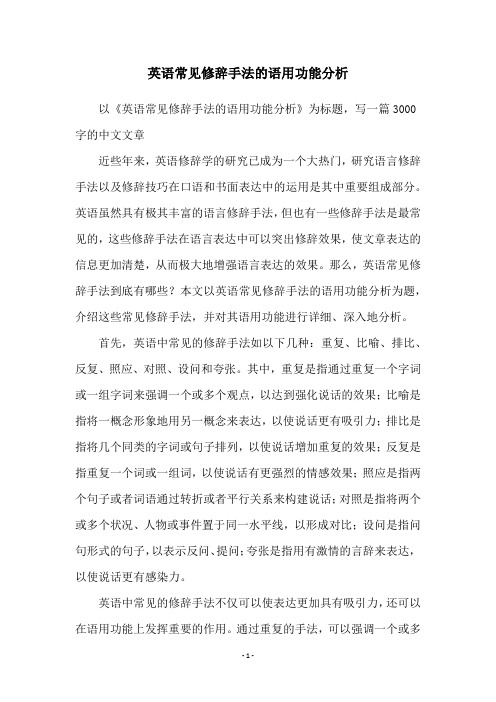
英语常见修辞手法的语用功能分析以《英语常见修辞手法的语用功能分析》为标题,写一篇3000字的中文文章近些年来,英语修辞学的研究已成为一个大热门,研究语言修辞手法以及修辞技巧在口语和书面表达中的运用是其中重要组成部分。
英语虽然具有极其丰富的语言修辞手法,但也有一些修辞手法是最常见的,这些修辞手法在语言表达中可以突出修辞效果,使文章表达的信息更加清楚,从而极大地增强语言表达的效果。
那么,英语常见修辞手法到底有哪些?本文以英语常见修辞手法的语用功能分析为题,介绍这些常见修辞手法,并对其语用功能进行详细、深入地分析。
首先,英语中常见的修辞手法如以下几种:重复、比喻、排比、反复、照应、对照、设问和夸张。
其中,重复是指通过重复一个字词或一组字词来强调一个或多个观点,以达到强化说话的效果;比喻是指将一概念形象地用另一概念来表达,以使说话更有吸引力;排比是指将几个同类的字词或句子排列,以使说话增加重复的效果;反复是指重复一个词或一组词,以使说话有更强烈的情感效果;照应是指两个句子或者词语通过转折或者平行关系来构建说话;对照是指将两个或多个状况、人物或事件置于同一水平线,以形成对比;设问是指问句形式的句子,以表示反问、提问;夸张是指用有激情的言辞来表达,以使说话更有感染力。
英语中常见的修辞手法不仅可以使表达更加具有吸引力,还可以在语用功能上发挥重要的作用。
通过重复的手法,可以强调一个或多个观点,加强表达的说服力;比喻的手法可以使表达更有生机,使说话更容易被听众理解;排比的手法可以使文章更具未知感,激发听众的兴趣;反复的手法可以使说话具有更强烈的情感,表达的内容更加激昂;照应的手法可以使表达的内容得到连贯,使说话更有层次;对照的手法可以使说话更加富有张力,使表达的对比更加激烈;设问的手法可以使表达的内容更有反问的效果;夸张的手法可以极大地增强感情色彩,使说话具有更强烈的抒情色彩。
以上是英语常见修辞手法及其语用功能分析,可见,英语中常见的修辞手法既可以增强言辞的吸引力,同时还可以在语用功能上发挥重要作用,从而使说话具有更强烈的说服力,增强说话的感染力。
赏析英美文学中的修辞手法

赏析英美文学中的修辞手法英美文学中的修辞手法是作文中常见的一种句式特点,被广泛运用于文学创作中,是文学作品最具艺术性的表达形式之一。
英文修辞手法可以分为外部修辞和内部修辞,除此之外还有英文语言的修辞手法:强调,比喻,近似比喻,反义,排比等。
这些修辞手法的运用能够使文章表达出优美的效果,从而更有说服力,同时也能够使文章得到更好的表现效果。
一、外部修辞外部修辞是指与文章的结构、编排相关的修辞手法,如并列句、对称句、押韵、押韵等。
并列句是将相似或者相关的句子并列在一起使用,它能够加强文章的结构,强调句子之间的逻辑关系,较好地表达出文章的中心思想。
对称句是指句子的结构是一种特殊的并列形式,句子之间也有一定的逻辑关系,能够抑制文章表达的单调,更具有文章的节奏感。
押韵技巧则是在文章中精心运用音节的重复,将两个或者多个音节的音素重复在一起,以营造出某种特殊的音乐氛围。
二、内部修辞内部修辞是指文章的精神性,形象性表现。
它可以通过使用比喻、近似比喻、反义、排比、夸张,以及其他形式的表述来更好地表达文章的主旨。
比喻是指在文中隐晦地把一种事物的属性、特质和另一种事物的属性、特质作比较、类比,以增强文章的感染力和表达力,更好地表达文章的中心思想。
近似比喻是指在文中直接把某一物体的属性、特质与另一物体的属性、特质作一种比较,起到表达情感的作用。
反义是指实际的现象和表象上形成一种反义和对比,强调文章的叙述,加强文章的节奏感和表达效果。
排比是指文章中运用结构相近、意义对应的句子连接在一起,形成表达效果的句子构造,加强句子之间的逻辑思维。
夸张是指在文章中运用夸张的手法来表达事物的程度,用想象力来强调文章的主题,更有力的表达文章的精神内涵。
三、英文修辞英文修辞手法主要包括强调、比喻、近似比喻、反义、排比等手法。
强调是在句子中用词语、结构或者句型强调文章中的某一词语,以使这一词语更加突出,更具有表现力。
比喻是指将文章中某一物体的属性或者特质比喻、暗示到另一种物体上,增加文章的生动性和表现力。
英文的修辞手法
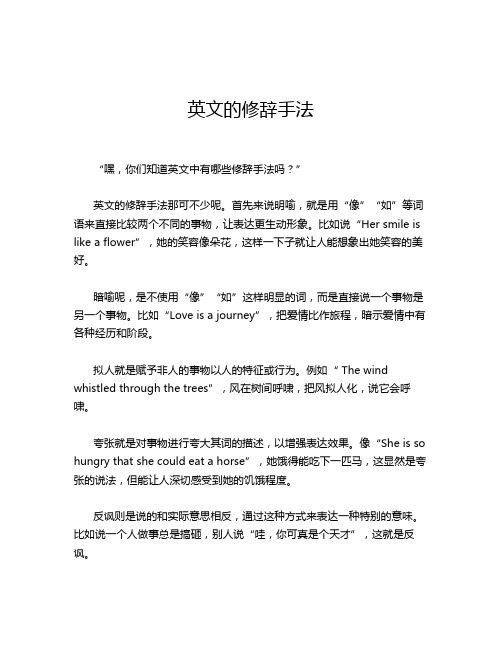
英文的修辞手法“嘿,你们知道英文中有哪些修辞手法吗?”英文的修辞手法那可不少呢。
首先来说明喻,就是用“像”“如”等词语来直接比较两个不同的事物,让表达更生动形象。
比如说“Her smile is like a flower”,她的笑容像朵花,这样一下子就让人能想象出她笑容的美好。
暗喻呢,是不使用“像”“如”这样明显的词,而是直接说一个事物是另一个事物。
比如“Love is a journey”,把爱情比作旅程,暗示爱情中有各种经历和阶段。
拟人就是赋予非人的事物以人的特征或行为。
例如“ Th e wind whistled through th e trees”,风在树间呼啸,把风拟人化,说它会呼啸。
夸张就是对事物进行夸大其词的描述,以增强表达效果。
像“She is so hungry that she could eat a horse”,她饿得能吃下一匹马,这显然是夸张的说法,但能让人深切感受到她的饥饿程度。
反讽则是说的和实际意思相反,通过这种方式来表达一种特别的意味。
比如说一个人做事总是搞砸,别人说“哇,你可真是个天才”,这就是反讽。
举个例子吧,在小说《哈利·波特》系列中,作者 J.K.罗琳就运用了很多修辞手法。
比如在描述霍格沃茨魔法学校时,会用夸张的手法来突出它的神奇和壮观,像那些会移动的楼梯、神奇的魔法生物等。
同时,对一些反派角色的描写也会用到反讽,让读者更能体会到他们的可憎之处。
还有借代,用一个事物来代表另一个相关的事物。
比如用“crown”(王冠)来代表王权。
象征就是用一个具体的事物来代表某种抽象的概念或情感。
像白鸽常常象征和平。
修辞手法的运用可以让英文表达更加丰富多彩,富有感染力和表现力。
掌握这些修辞手法,无论是在写作还是日常交流中,都能让我们的语言更加出色,更能准确地传达我们的意思和情感。
所以啊,大家可得好好琢磨琢磨这些修辞手法,让自己的英文水平更上一层楼呢!。
- 1、下载文档前请自行甄别文档内容的完整性,平台不提供额外的编辑、内容补充、找答案等附加服务。
- 2、"仅部分预览"的文档,不可在线预览部分如存在完整性等问题,可反馈申请退款(可完整预览的文档不适用该条件!)。
- 3、如文档侵犯您的权益,请联系客服反馈,我们会尽快为您处理(人工客服工作时间:9:00-18:30)。
Requirements
Class attendance Previewing Active Participation in the Class Assignments Reviewing before the exam
Rhetoric 修辞学
Introduction
The Classical Rhetoric
Division of Rhetoric
Communicative Rhetoric 交际修辞 (Negative Rhetoric 消极修辞) -- To add to people’s knowledge; accurate, plain; Aesthetic Rhetoric 美学修辞 (Positive Rhetoric 积极修辞) -- To get people affected, or moved; vivid, brilliant, colorful.
The three uses of similes:
Descriptive描述型明喻; Illuminative启示型明喻 ; Illustrative说明型明喻;
;
Descriptive 描述型
Her lips were red, her locks were yellow as gold. Pop looked so unhappy, almost like a child who’s lost his piece of candy. The big black flies hit us like bombs.
Its function is to give deeper insight
into persons or things.
The quality that similes must possess:
Freshness Originality The repeatedly used similes should be avoided: e.g. as cold as ice; as good as gold; as strong as an ox; as cunning as a fox;
Illuminative启发型
E.g.
What happened to a dream deferred (postponed)? Like a raisin (葡萄干) in the sun? Or fester (化脓) like a sore? Does it stink like a rotten meat?
10th Week: Chapter 12 (Climax and Anticlimax 层进与 突降) 11th Week: Chapter 13 and 14 (Hyperbole, Euphemism and Understatement 夸张,委婉语和低调 陈述) 12th Week: Chapter 15 and 16 (Pun and Antithesis 双 关语和对照) 13th Week: Chapter 17 (End Weight 重尾) 14th Week: Chapter 18 (Phonetic Rhetoric 语音修辞) 15th and 16th Week: Reviewing:①Communicative Rhetoric Aesthetic Rhetoric 交际修辞与美学修辞, ② figures of speech各种修辞手段
Illustrative说明型
E.g. What is tennis? Tennis is like a pingpong game scaled up to a sizable court. Its function is to explain abstract or complicated ideas or things unfamiliar to you in simple, concrete ideas, or things familiar to you.
tycoon
successful businessman detective prisoner
spy jailbird
Group 2: the Origin of the Word (词 词 源): “commence”; Group 3: Historical Origins (历史渊 历史渊 源) of a Word: “gringo”; “blackmail”;
Group 6: the Association with the Knowledge on Medicine, Science and Technology (科技常识中的联想 科技常识中的联想): 科技常识中的联想 “anemic”; “allergic”; “surgical”; -- These three words are also cases of metaphor.
Compare the following sentences: Jim looks like his brother Billy. My car runs as fast as the train. A real friend is like a mirror that can help you see any dirt on your face. Life was like a journey full of pitfalls. -- (The first two sentences are not cases of simile.) Simile is a comparison between two unlike things across domains (跨领 域).
英语修辞赏析
秦妍
Syllabus 教学纲要
1st, 2nd Week: Introduction: Chapter 1 (Introduction绪 论) 3rd Week: Chapter 3 (Choice of Diction用词精当) 4th Week: Chapter 6 (Simile and Metaphor:明喻和暗喻) 5th Week: Chapter 6 (Simile and Metaphor continued; Synecdoche and Personification 提喻和拟人) 6th Week: Chapter 7 (Metaphor 借代) 7th Week: Chapter 8 (Antonomasia 换称) 8th Week: Chapter 9 (Bifocal Visions 双重聚焦) 9th Week: Chapter 10 and 11 (Transferred Epithet and Rhetorical Repetition 移就和叠言)
*Stylistics
语体文体修辞学
-- is focused on different types or styles of writing: e. g. News English, Oral English, Scientific English, personal style of a writer, or the style of a certain period, etc.
中性
government employee investor policeman spokesman union official
legal consultant lobbyist labor leader union boss
captain of industry investigator captive
Why Do We Learn Rhetoric?
To understand the author’s intention better. To find out the common ways people know the world and ways people express themselves. To appreciate the beauty, explicit or not, of the language. To learn how to achieve an effective communication.
*Rhetoric
人文修辞学
-- deals with the choosing of the most appropriate words for a particular circumstance.
Байду номын сангаас
What is Rhetoric?
It is more than those figures of speech (修辞格), such as simile (明 喻), metaphor (隐喻), metonymy (借 代), or personification (拟人). Rhetoric is wording.
Group 4: Polysemy (一词多义 一词多义): 一词多义 “arsenal”; “arrival”; “beam”; Group 5: Resorting to Image (借助 借助 意象): 意象 “bath”; “on knife’s edge”; “latch onto”; “finger”;
Chapter 3 Choice of Diction用词精当 The examples chosen: Group 1: the Connotation (内涵 of a 内涵) 内涵 Word: “Jess”, “The person” “caliber”; “persona”; “proportion”; “savvy”; “set”;
Connotation of words
Connotation is the association and the overtones about that word. “thick in body because of presence of superfluous flesh”: “stout”: suggesting robust health; “plump”: suggesting a pleasant fullness of figure; “fat”: suggesting the neutral, general uncomplimentary connotation; “obese”: implying un unhealthy excess of fat;
